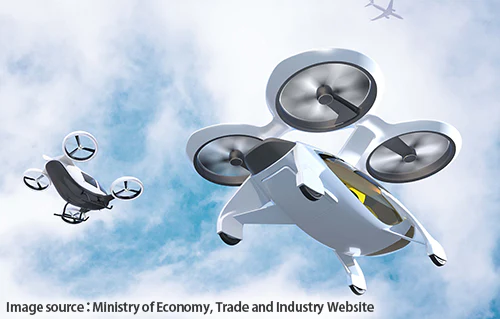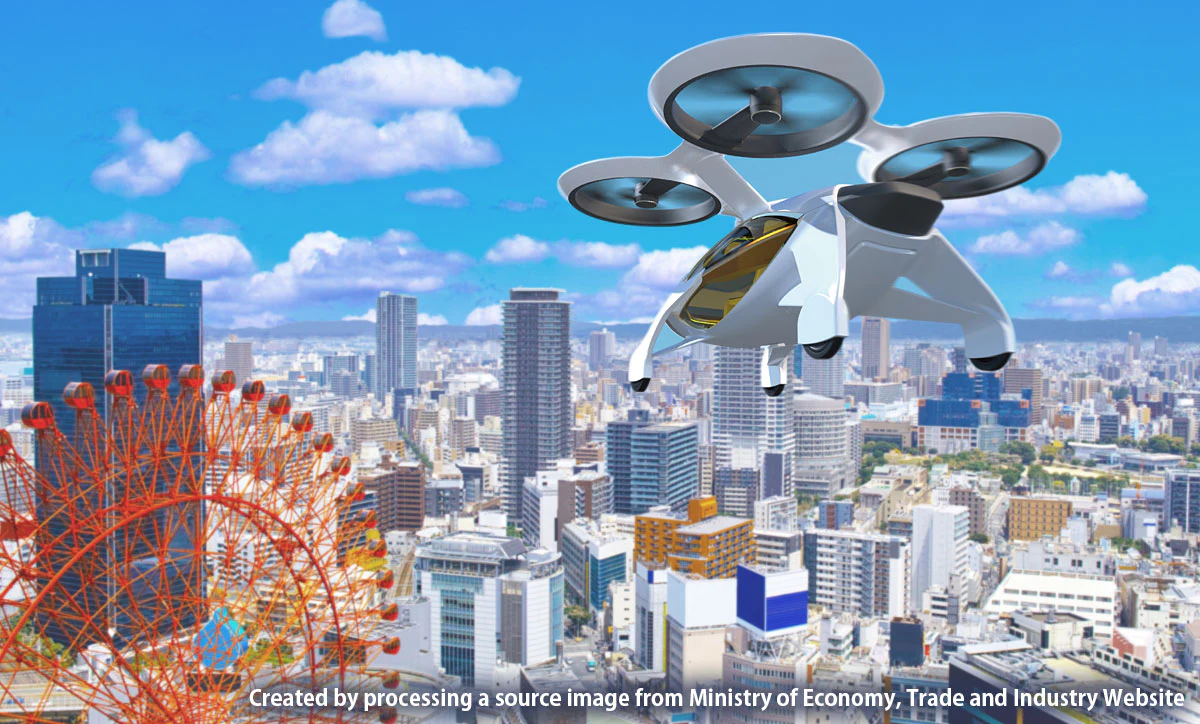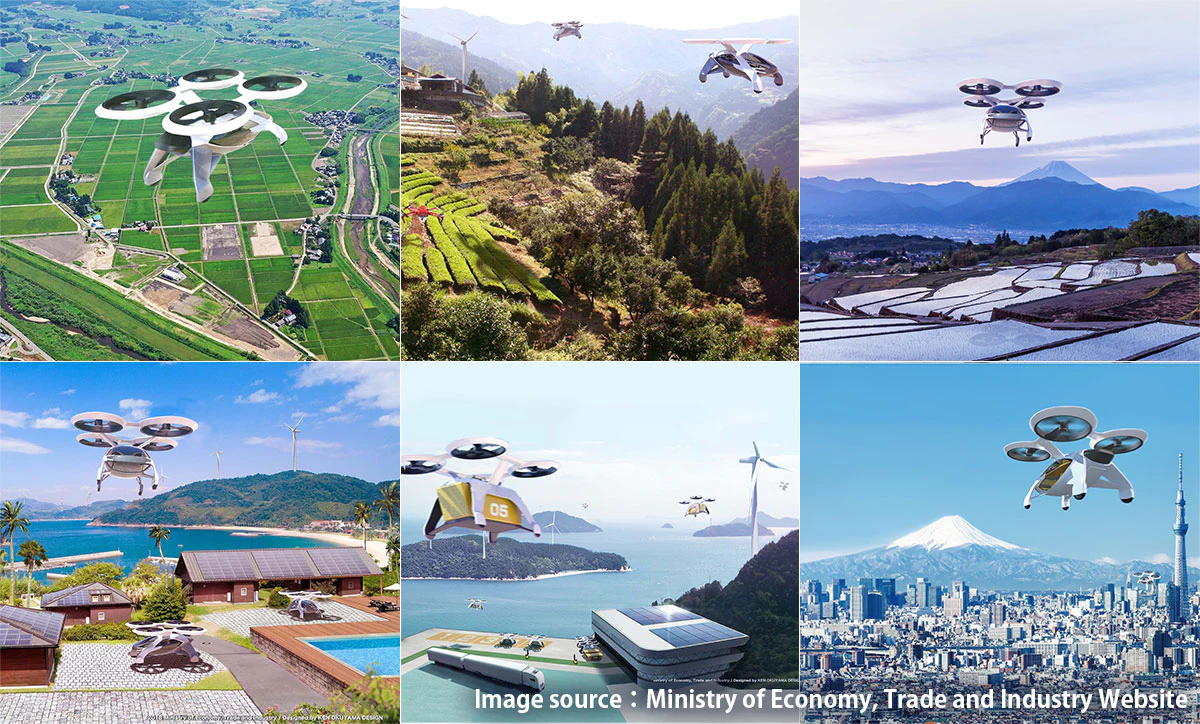Promoting the creation of systems and standards to realize the "Advanced Air Mobility" that mankind has been dreaming of.
Release:
Update:
NEW

CHALLENGE
"Advanced Air Mobility" service to start operating from Osaka Expo 2025
The scenery of Advanced Air Mobility equipped with seats on multi-copters (large drones with multiple blades) flying across the sky is the very image of the near future. Demonstration experiments have already been conducted around the world, and the national and local governments in Japan have begun to move towards its realization.
While the status of aircraft development by specialized manufacturers is reported in press releases, what we at Nippon Koei are working on is the process of solidifying the systems and standards for operation. Where will the aircraft take off and land, what kind of location and environment is suitable for the take-off and landing site be in, and what kind of functions are appropriate? How will the environmental assessment be formulated? How should traffic rules be determined that are consistent with traffic control and aviation laws? What kind of charging facility would satisfy both the Fire Service Law and the Electrical Engineering Ordinance? How will it contribute to enhancing the value of the surrounding area? The Advanced Air Mobility project is humanity's first attempt, so there are a lot of issues that no one has ever experienced.
Even if it is an unknown area, if we do not solve the problems, there is no future. In order to break the status quo, the government established a public-private council and began to create systems and standards. Since its founding, Nippon Koei has been making use of its experience in building various types of infrastructure and creating cities to make proposals and recommendations at discussion forums such as the Advanced Air Mobility conference. For example, there are only a few companies in Japan that have the expertise to design and maintain airports and heliports. Our strength lies in the fact that we can conduct various studies as a single company, as we have specialized departments for large segments that would otherwise be completed by one company, such as transportation infrastructure planning, environmental assessment, and electric power.
The specific goal is to develop a service of flying around and moving between two bases at the Osaka Expo in 2025. By bringing together all the experience and technology gained from building infrastructure and creating cities, we are challenging ourselves to make Advanced Air Mobility a reality as transportation infrastructure.
Created by processing a source image from Ministry of Economy, Trade and Industry Website

SOLUTION
Specific institutional development, such as defining requirements for Vertiport and environmental assessments, has begun.
The movement to realize Advanced Air Mobility in Japan accelerated in 2018. The Ministry of Economy, Trade, and Industry established the "Public-Private Council for the Revolution of Air Mobility", marking the first year of air mobility in Japan. The first step was to create a roadmap for concrete social implementation. This was followed by the design of a system and rules to achieve this.
A typical example used as a reference was the heliport system and standards. The discussion focused on modifying existing systems and creating new systems that could accommodate advanced air mobility.
An example of what we have taken advantage of is the requirements for vertiport. The major difference between a helicopter and Advanced Air Mobility is the travel route when taking off and landing. While helicopters travel at a slight angle, Advanced Air Mobility have the potential to take off and land vertically. In other words, a field size of 20 to 30 square meters, like a helipad, is sufficient, but surrounding buildings should have their own height limits for Advanced Air Mobility. For the latest information, in February and March of 2022, aviation regulators in the United States and Europe will announce a draft version of the vertiport standards. We are now in the stage of considering whether the European and American standards can be applied to Japan, which will allow for more detailed examination.
In addition, the development of environmental assessment has been mentioned as a major challenge in parallel. This is to anticipate the impact of a major project such as civil engineering or construction and to take countermeasures. This assessment is set for each project, such as dams, highways, and airports, but no country or city has prepared anything yet for Advanced Air Mobility that will be realized in the future. Therefore, the knowledge of companies that have extensive experience in environmental assessment is required. Nippon Koei has accumulated experience not only in dams and expressways, but also in environmental assessments of airports and heliports.
One area of debate is the introduction of a noise element. The Advanced Air Mobility is electric, but flies at a lower altitude than a regular plane or helicopter. For this reason, the impact of sound, especially on houses, schools, and hospitals, must be reduced as much as possible. In addition to creating evaluation criteria while assuming the situation after completion, we are now in the preparatory stage of formulating tailor-made measures.
POINT
From Advanced Air Mobility to a better future for our city
Image source:Ministry of Economy, Trade and Industry Website

Nippon Koei, which has strived to enrich and comfort the land and its residents as a consulting firm, has engineers specializing in a wide range of fields. Since the company's founding, each engineer has been working as a professional to enhance their technical skills.
Until about 10 years ago, technical skills and the ability to make proposals in specialized fields were required, but in recent years, there has seen an increasing demand for solutions to larger social issues. Smart city initiatives are a prime example. We are advancing this Advanced Air Mobility project by leveraging the various departments within the company.
The Advanced Air Mobility and air mobility business cannot thrive solely on aircrafts and vertiports. If it is realized and begins operation, the appearance of the city itself may change significantly. Therefore, we do not see Advanced Air Mobility as a standalone business, but as something that will be linked to smart cities and MaaS, which stands for Mobility as a Service, a new integrated transportation system.
The strength we have cultivated is that we can make plans and proposals from any angle at one stop. We have a system in place to assist local governments in implementing Advanced Air Mobility from the earliest stages to the operational phase.
As a consulting firm, Nippon Koei will continue to provide forward-looking proposals and plans towards the realization of Advanced Air Mobility, a long-held vision of mankind.



